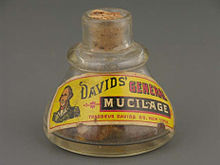Mucilage
Mucilage is a thick gluey substance produced by nearly all
Occurrence
Exopolysaccharides are the most stabilising factor for
Mucilage has a unique purpose in some carnivorous plants. The plant genera Drosera (sundews), Pinguicula, and others have leaves studded with mucilage-secreting glands, and use a "flypaper trap" to capture insects.[4]
Human uses

Mucilage is edible. It is used in medicine as it relieves irritation of mucous membranes by forming a protective film. It is known to act as a soluble, or viscous, dietary fiber that thickens the fecal mass, an example being the consumption of fiber supplements containing psyllium seed husks.[5]
Traditionally, marshmallows were made from the extract of the mucilaginous root of the marshmallow plant (Althaea officinalis). The inner bark of the slippery elm (Ulmus rubra), a North American tree species, has long been used as a demulcent and cough medicine, and is still produced commercially for that purpose.[6]
Mucilage mixed with water has been used as a
The mucilage of two kinds of
Ecological implications for plants
The presence of mucilage in seeds affects important ecological processes in some plant species, such as tolerance of water stress, competition via
A variety of
Plant sources
The following plant and algae species are known to contain far greater concentrations of mucilage than typical:
- Aloe vera
- Althaea
- Basella alba (Malabar spinach)
- Cactus
- Chondrus crispus (Irish moss)
- Corchorus (jute plant)
- Dioscorea polystachya(nagaimo, Chinese yam)
- Drosera (sundews)
- Drosophyllum lusitanicum
- Fenugreek
- Flax seeds
- Kelp
- Liquorice root
- Mallow
- Mullein
- Okra
- Nopal
- Parthenium
- Pinguicula (butterwort)
- Plantago major (greater plantain)
- Psyllium seed husks
- Salvia hispanica seed (chia)
- Talinum triangulare(waterleaf)
- Taro
- Ulmus rubra bark (slippery elm)
See also
- Marine mucilage, also known as sea snot – Type of organic matter found in the sea
References
- ^ "Modes of Locomotion in Protists: 5 Modes". Biology Discussion. 6 September 2016. Archived from the original on 24 December 2017. Retrieved 26 October 2017.
- ^ "Mucilage cell, cactus". www.sbs.utexas.edu. Archived from the original on 15 June 2017. Retrieved 26 October 2017.
- ISBN 9780080475141. Archivedfrom the original on 24 December 2017.
- ^ "Carnivorous Plant Trapping Mechanisms". International Carnivorous Plant Society. Archived from the original on 6 April 2016. Retrieved 29 March 2016.
- ISBN 978-0-309-07564-0.
- ^ "Slippery Elm". University of Maryland Medical Center. Archived from the original on 17 November 2015.
- ^ Spitzenberger, Ray (23 August 2007). "Glue, Paste or Mucilage: Know the Difference?". East Bernard Express. East Bernard, TX. Retrieved 29 March 2016.
- ISBN 978-1-113-00611-0.
- ^ "Drosera L." Plants of the World Online. Royal Botanic Gardens, Kew. Retrieved 16 March 2023.
- ^ "Filmjölk från Linnés tid" (PDF). Verumjournalen (in Swedish). 2002: 10. 2002. Retrieved 18 July 2007. [permanent dead link]
- ^ Östman, Elisabeth (1911). "Recept på filmjölk, filbunke och långmjölk". Iduns kokbok (in Swedish). Stockholm: Aktiebolaget Ljus, Isaac Marcus' Boktryckeriaktiebolag. p. 161. Archived from the original on 29 October 2008. Retrieved 18 July 2007.
- ^ "Vad gjorde man med mjölken?" (in Swedish). Järnriket Gästrikland, Länsmuseet Gävleborg. Archived from the original on 22 March 2007. Retrieved 5 August 2007.
- JSTOR 2257664.
- PMID 16653018.
- PMID 20348559.
- PMID 21912689.
- PMID 23126286.
- ISSN 0037-7333.
External links
- Mucilage Columbia Encyclopedia, Sixth Edition (2007).
- Chisholm, Hugh, ed. (1911). . Encyclopædia Britannica. Vol. 18 (11th ed.). Cambridge University Press. p. 954.
